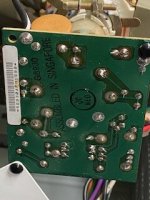aeberbach
Well-known member
Hi everyone - first post.
I have looked on eBay for the SE/30 for ages but never before been quick enough or not been outbid. Well I finally got one. It's not perfect but I think it's. good buy!
First, the box. Shipping was from Western Australia to me in Victoria, it travelled about 3500km in just four days which has to be some kind of record. When I opened the box I felt pretty lucky that the side of the Mac hasn't been caved in by something placed on top, just a layer of bubbles and three thin layers of cardboard protected it.

Did it work? Works great!

Next, what's happening inside? Oh, someone has been here before... at least the battery isn't going to explode, though it was rattling around loose in there.

Someone who only had radial electrolytics in stock! And didn't know about cleaning flux.

Cleaning and removing them was a big job, lots of flux, lots of alcohol, lots of desoldering pump and wick. Those holes for the big radial caps are so hard to clear. C9 has me worried - when I was cleaning solder off I felt something move and I thought the pad had lifted, but it was just a piece of the old surface mount capacitor leg that someone hadn't bothered to remove.

Everything cleaned up nicely. The only lasting damage seems to be some corrosion near C12, solder mask has lifted but the copper trace is intact. Do you think I should scrape oxidisation off and tin that piece of exposed copper?

I'm waiting on new surface mount caps so for now I can't test anything but it came up very nicely after a clean with detergent and a rinse with some isopropyl alcohol, then a hot air dry.
There is a wire connecting pin 3 of 341-0665-A to a via. It looks like a factory fix because of the neat Lynar wire used and the way it is glued down. Do most SE/30s have this?
And finally... it has this neat Radius video card! Anyone know what this is? I suspect it is a color card that will drive my Blueberry 12" Studio Display?

There's a lot of work do do on this Mac. I expect to replace caps on the video and power supply as well as the picture is a little jittery and it doesn't appear that those components were touched by the previous owner.
Any disadvantage to staying with a pair of alkaline batteries for PRAM?
(sorry the images don't link to their full size images, imgur album below)
Imgur album
I have looked on eBay for the SE/30 for ages but never before been quick enough or not been outbid. Well I finally got one. It's not perfect but I think it's. good buy!
First, the box. Shipping was from Western Australia to me in Victoria, it travelled about 3500km in just four days which has to be some kind of record. When I opened the box I felt pretty lucky that the side of the Mac hasn't been caved in by something placed on top, just a layer of bubbles and three thin layers of cardboard protected it.

Did it work? Works great!

Next, what's happening inside? Oh, someone has been here before... at least the battery isn't going to explode, though it was rattling around loose in there.

Someone who only had radial electrolytics in stock! And didn't know about cleaning flux.

Cleaning and removing them was a big job, lots of flux, lots of alcohol, lots of desoldering pump and wick. Those holes for the big radial caps are so hard to clear. C9 has me worried - when I was cleaning solder off I felt something move and I thought the pad had lifted, but it was just a piece of the old surface mount capacitor leg that someone hadn't bothered to remove.

Everything cleaned up nicely. The only lasting damage seems to be some corrosion near C12, solder mask has lifted but the copper trace is intact. Do you think I should scrape oxidisation off and tin that piece of exposed copper?

I'm waiting on new surface mount caps so for now I can't test anything but it came up very nicely after a clean with detergent and a rinse with some isopropyl alcohol, then a hot air dry.
There is a wire connecting pin 3 of 341-0665-A to a via. It looks like a factory fix because of the neat Lynar wire used and the way it is glued down. Do most SE/30s have this?
And finally... it has this neat Radius video card! Anyone know what this is? I suspect it is a color card that will drive my Blueberry 12" Studio Display?

There's a lot of work do do on this Mac. I expect to replace caps on the video and power supply as well as the picture is a little jittery and it doesn't appear that those components were touched by the previous owner.
Any disadvantage to staying with a pair of alkaline batteries for PRAM?
(sorry the images don't link to their full size images, imgur album below)
Imgur album
Last edited by a moderator:


